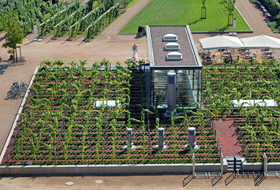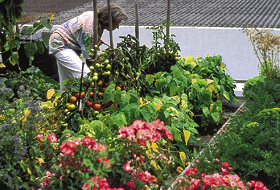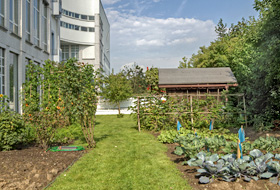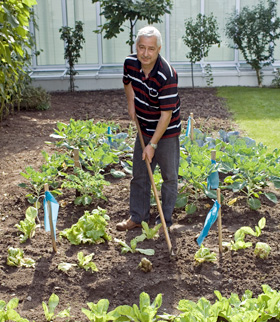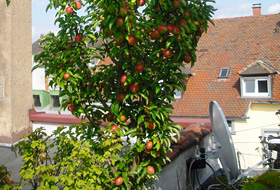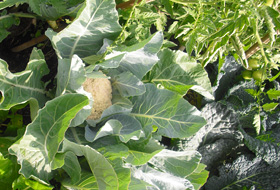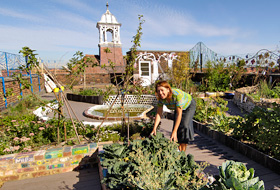
Urban rooftop farming
Press release, 27 July 2012
|
|
The concept of “urban farming”, i.e. farming in the city, is not new. Set against the backdrop of the New York skyline, urban farming has even made it into the Deutsche Bahn customer magazine. The idea has actually been around a long time, even in Germany. There are plenty of possible large and small vegetable plots at ground level, be it in unused back yards or brownfield sites. However, the numerous flat roofs available provide an almost greater potential. The sophisticated and well-engineered ZinCo systems provide a permanent reliable basis, even for rooftop farming. The number of densely populated urban centres continues to increase and now more than half of the world’s population lives in towns or cities. According to the Federal Ministry for Building and Regional Planning and the Federal Ministry for the Environment, 50 percent of the land used for human settlement and infrastructure in Germany is already covered. About 110 hectares are added to this on a daily basis, resulting in the loss of farmland. Offsetting this, green roofs have made the breakthrough in densely populated areas. It comes as no surprise, therefore, that green roofs are used to grow vegetables, fruit and herbs as the benefits here are considerable both in environmental and economic terms. Growing benefitsIn this “Age of Less“ and of the “Slow Food Movement”, local and seasonal produce are more popular than ever before. A representative survey carried out by the Forsa Institute in 2010 on behalf of the Federal Department of Agriculture showed that, when purchasing groceries, 65% of consumers usually or always ensure that the produce is sourced regionally. The market desires regionality. Thinking in terms of the circular economy that incorporates urban vegetable production is lucrative, as rooftop farming uses local resources: rain water and filtered waste water from the households; solar energy and the heat generated by the building. Conversely, the urban garden can be of benefit to the building, as the plants provide cooling in the summer and thermal insulation in the winter: it’s good for the building climate and just as good for the roof waterproof membrane, which is then exposed to less severe temperature fluctuations. In addition, plants help to improve the urban climate. Technology for a fruitful harvestIn order for market gardening to work in an extreme location such as a rooftop, however, all relevant factors must be taken into consideration. For this reason, ZinCo has created the permanent reliable system build-up “Urban Rooftop Farming”. The drainage element Floradrain® FD 40 is at the heart of this build-up. With about 20 cm of ZinCo system substrate, this build-up is suitable for growing many different types of vegetable and fruit for example lettuce, onions, herbs, courgettes, aubergines, pumpkins, cabbage, melons and strawberries. A somewhat deeper substrate layer (28 to 40 cm) is required for tomatoes, French beans, raspberries, blackberries, currants and the like. The level of irrigation and fertilisation required will depend on the vegetables to be grown and local climate conditions. Generally speaking, pathways are useful in a vegetable garden. The ZinCo system build-up “Urban Rooftop Farming” provides for drainage throughout the entire green roof, even where there is a combination of surfaces, with the result that roof run-offs can be situated in places where they are least disruptive. The specific requirements of a rooftop location (for example in terms of wind, structural requirements, water run-off) must be taken into consideration during the planning phase. As is the case with all roofs that are going to be used by people, fall-protection measures must be included. ZinCo provides suitable systems and rail solutions, all of which can be installed without penetrating the roof membrane. In any case, it is important to ensure safe access to and on the roof area. Developments worldwideIn urban farming you can basically differentiate between private and commercial use of the vegetable garden. The latter is carried out on rooftops either in the open or under glass. In the international arena, large cities in the USA and Central America are forging ahead with urban farming. In Brooklyn, lettuce is grown across an area of 1,500 m². Commercial projects are already underway in Los Angeles, Dubai and Shanghai. The example of a large supermarket chain is pointing in the same direction: in 2012, production is starting up in rooftop glasshouses in three different locations in the USA where fruit, vegetables and lettuce will be supplied directly from the roof to the point of sale. In Germany, there are already numerous different examples of urban farming, mainly private projects. Private roof gardens in Karlsruhe and Wendlingen (see photos) show that urban farming can be very successful even with limited space. Larger plots are available on the roof of the Technoseum in Mannheim. This rooftop allotment, about 600 m² in size, is part of a permanent exhibition showing visitors how people lived and fed themselves in former times. In Radebeul, near Dresden we have an example of commercial use: some of the vines at the state winery, Schloss Wackerbarth, are grown on the roof, promising a full-bodied taste. Roofs of the futureWhat may initially appear to be futuristic can become reality if the correct technical expertise is applied – growing vegetables on a roof. Urban roofs are providing new fields of activity - as farmland or gardens where we can experience nature at first hand or social areas where the community can come together. Whether it’s on a small or a grand scale, for private or commercial use, there are many benefits to urban farming. It is also a way of addressing the lack of resources and farmland that has resulted from increasing urbanization. Author: Dieter Schenk, Managing Director ZinCo GmbH For further information, please contact: ZinCo GmbH |
